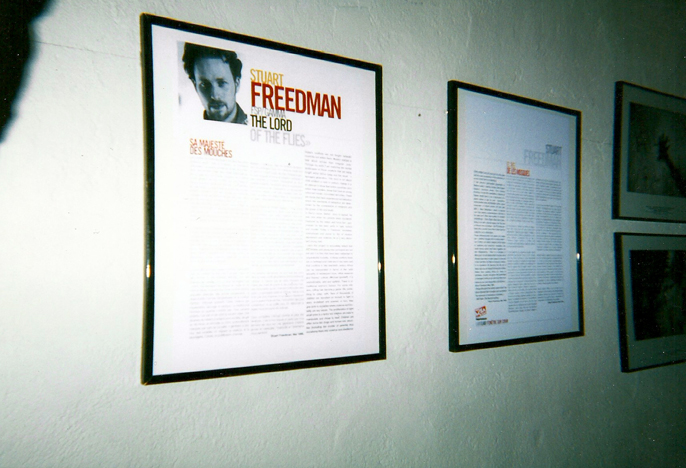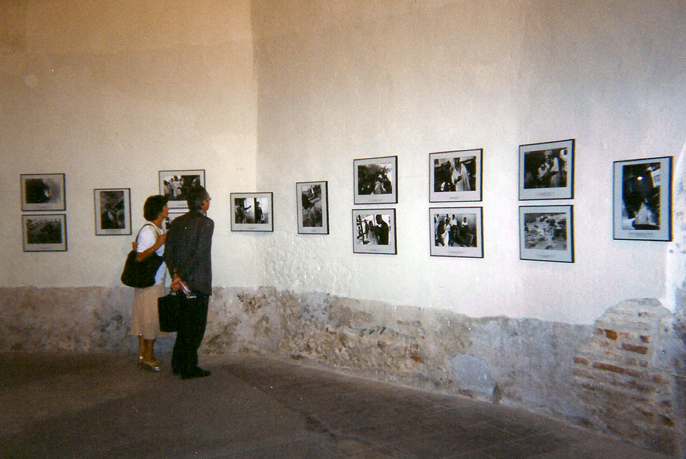This year is the 25th anniversary of the photojournalism festival held every year in Perpignan: Visa pour l’Image. In 1998 I had a show there with a two-year body of work from Africa called The Lord of the Flies. Since then, some of my work has also been projections but that first show was a really special moment and meant a great deal to me. I remember that I arrived in Paris to see the enigmatic founder of Visa, Jean Francois Leroy clutching a box of fibre prints under my arm. After he saw the first three images he stopped and said, “OK, you have the exhibition…” I was so shocked that I thought he was joking and I told him so. He assured me that he wasn’t and we signed a contract there and then. I walked around Paris that day at least a foot taller. It marked a turning point in my career and the first real recognition that I was on the right path professionally.
Subsequently, I’ve had an uneven relationship with Visa. I think it’s true to say that I find the whole networking aspect pretty uncomfortable and certainly it seems to bring out the worst in terms of ego in some people in the industry. Because of that, I haven’t been since the demise of Network. It might well be said that the exhibition selections also conform to a very rigid view of the world and of photojournalism. As I am writing this however, it occurs to me that although that certainly is problematic, I’m probably more on the side of Visa than I am of the narcissistic trend in what I’d call personal reportage about/within the world. I mean by that a self conscious style – a bleed from the art world that I see a good deal now. This is generally medium format, generally about close focus on objects and a melancholy that seems to me like a teenage angst. “Oh the world is so terrible/Oh, but it’s so beautiful/I’m so original and important” In a funny way, despite the protestations of ‘artists’ who photograph like this, stylistically it has more to do with them than what they purport to be photographing. I wouldn’t shoot The Lord of the Flies in the same way now (I probably wouldn’t shoot it in black and white for a start because of the connotations I think that has in terms of the West reporting Africa now) but serious stories that never get anywhere near a magazine do have a home at Visa and I hope that that continues. If nothing else and despite all its faults, Visa does stand for an engagement even if that is a little blunt and simplistic. The selection is purely down to Leroy and good luck to him. As he says in a very interesting interview with Time here, “You can like my taste or not, but at least you can see that there is a strong line”. He is also – absolutely correctly – critical of young photographers who have no idea of the heritage within the industry in which they are working. As Leroy points out “It’s very difficult to do a reportage about prostitutes in India, if you’re not familiar with the work of Mary Ellen Mark”. The internet generation may have more cameras and more opportunity to take pictures but they seem to have, according to Leroy, very little ability to tell stories. I agree. A random set of images are not a photo essay. This is worth quoting in full:
“It’s not because I have a pencil that I’m Victor Hugo or Shakespeare. It’s not because you have a camera, that you are a photographer. There is currently a trend in photography to cover specific communities, like poor people in Ohio, or very poor people in Connecticut, or really, really poor people in Arkansas etc. Where is the story? The other favorites are: my mother has breast cancer, my father has Alzheimer’s, my brother is a schizophrenic. I know these kind of stories. It’s personal, yes, but I’m not sure it makes good work”
Crucially for me, when Leroy is asked about advice for young photographers, he says “Work, work, work. Read everything done before you”. I couldn’t agree more. One’s work, although unique, is in a continuity; a flow of humanity and journalism gone before that is bigger than each of us but one that by adherence to an ethical framework, should be there to bear witness not simply to suffering but a better world. That multi-faceted, outward-looking storytelling is what is sorely lacking in much of visual journalism today and what Visa – with all it’s problems, it’s cliches and idiosyncrasies – is still largely about. Personally, I can’t stand the ‘Scarf and Leica brigade’ with their egos and delusions about being heroes but at least that tradition (although I’m the first to admit it needs a re-invigoration) is about reporting and not about photographing dying flowers as metaphor. In a world where print media and funding have almost disappeared, at least Visa is still there.
Here are a couple of images from my show at the Couvert des Minimes, Visa Pour L’Image all those years ago.

